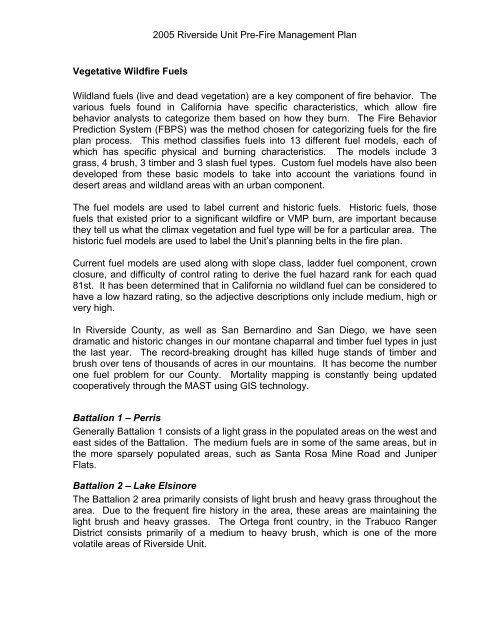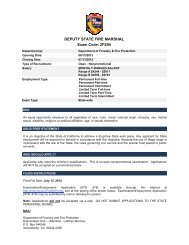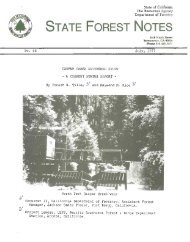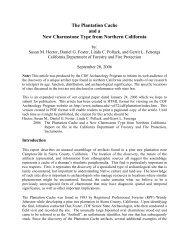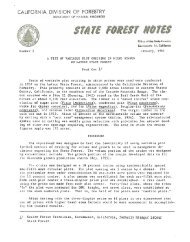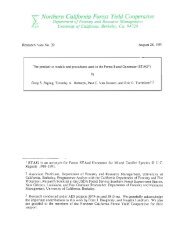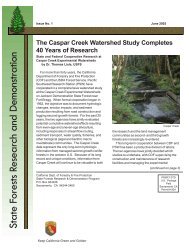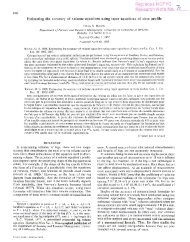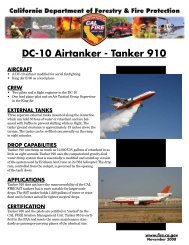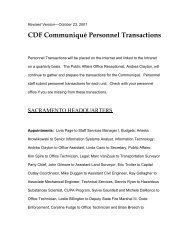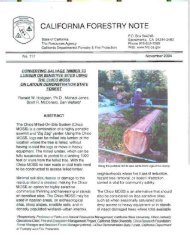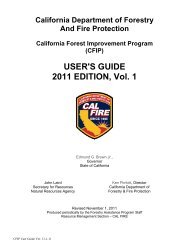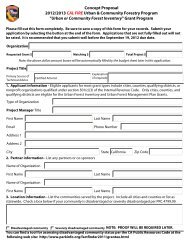You also want an ePaper? Increase the reach of your titles
YUMPU automatically turns print PDFs into web optimized ePapers that Google loves.
Vegetative Wildfire Fuels<br />
2005 Riverside <strong>Unit</strong> Pre-Fire Management Plan<br />
Wildland fuels (live and dead vegetation) are a key component <strong>of</strong> fire behavior. The<br />
various fuels found in <strong>California</strong> have specific characteristics, which allow fire<br />
behavior analysts to categorize them based on how they burn. The Fire Behavior<br />
Prediction System (FBPS) was the method chosen for categorizing fuels for the fire<br />
plan process. This method classifies fuels into 13 different fuel models, each <strong>of</strong><br />
which has specific physical and burning characteristics. The models include 3<br />
grass, 4 brush, 3 timber and 3 slash fuel types. Custom fuel models have also been<br />
developed from these basic models to take into account the variations found in<br />
desert areas and wildland areas with an urban component.<br />
The fuel models are used to label current and historic fuels. Historic fuels, those<br />
fuels that existed prior to a significant wildfire or VMP burn, are important because<br />
they tell us what the climax vegetation and fuel type will be for a particular area. The<br />
historic fuel models are used to label the <strong>Unit</strong>’s planning belts in the fire plan.<br />
Current fuel models are used along with slope class, ladder fuel component, crown<br />
closure, and difficulty <strong>of</strong> control rating to derive the fuel hazard rank for each quad<br />
81st. It has been determined that in <strong>California</strong> no wildland fuel can be considered to<br />
have a low hazard rating, so the adjective descriptions only include medium, high or<br />
very high.<br />
In Riverside County, as well as San Bernardino and San Diego, we have seen<br />
dramatic and historic changes in our montane chaparral and timber fuel types in just<br />
the last year. The record-breaking drought has killed huge stands <strong>of</strong> timber and<br />
brush over tens <strong>of</strong> thousands <strong>of</strong> acres in our mountains. It has become the number<br />
one fuel problem for our County. Mortality mapping is constantly being updated<br />
cooperatively through the MAST using GIS technology.<br />
Battalion 1 – Perris<br />
Generally Battalion 1 consists <strong>of</strong> a light grass in the populated areas on the west and<br />
east sides <strong>of</strong> the Battalion. The medium fuels are in some <strong>of</strong> the same areas, but in<br />
the more sparsely populated areas, such as Santa Rosa Mine Road and Juniper<br />
Flats.<br />
Battalion 2 – Lake Elsinore<br />
The Battalion 2 area primarily consists <strong>of</strong> light brush and heavy grass throughout the<br />
area. Due to the frequent fire history in the area, these areas are maintaining the<br />
light brush and heavy grasses. The Ortega front country, in the Trabuco Ranger<br />
District consists primarily <strong>of</strong> a medium to heavy brush, which is one <strong>of</strong> the more<br />
volatile areas <strong>of</strong> Riverside <strong>Unit</strong>.


